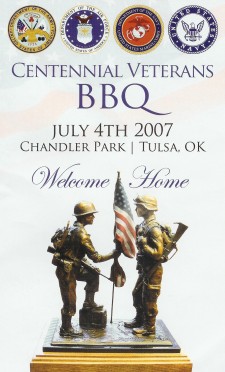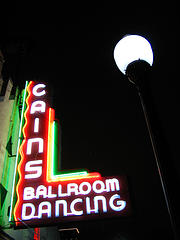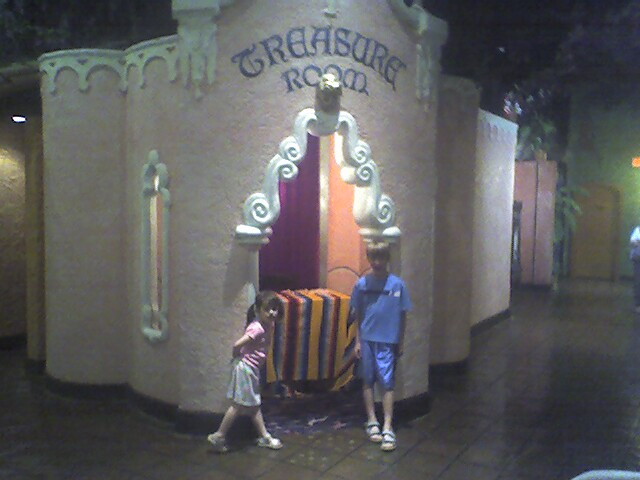When Weird Al Yankovic performs tomorrow night at the River Parks Amphitheatre -- the postponement of Friday's storm-cancelled performance -- it would be appropriate to lead off with "Amish Paradise". We were among tens of thousands of Tulsans to get a generous taste of life disconnected from the grid. Amish, yes. Paradise, well....
The power went off about 5:30 Friday afternoon. I was working late, Mikki and the kids were about to leave to go over to my folks' house for a visit. Earlier in the day, they had finished baking a football-shaped cake for Joseph's birthday party the next day. When I got home, just ahead of them about 9, the power was still out, all over the neighborhood. No storm damage to the house, a tree lost a limb, but no apparent damage to the lines leading to our home. We've had our problems with power -- a sequence of squirrels who committed suicide attacks on the transformer, a lightning strike on a transformer which started a small and brief grass fire in a neighbor's yard -- but never a long outage.
The rest of the family returned soon after, and we worked on getting everyone ready for bed in the dark. We opened some windows to get air moving through the house. The temperature had dropped and there was a good breeze, so it was fairly comfortable. We had some battery-powered lanterns we could scatter around the house, so we didn't have to deal with the heat or danger of candles. Everyone slept well except me. I kept imagining that the flashes of lightning were the lights from a PSO truck come to fix things, and I kept thinking about all the food in the deep freeze.
We slept later than we should have. The other side of the street had power; we were still out. I took the kids with me to verify that Whiteside Park Recreation Center -- where we were having the party -- had power, and then to get some lunch. I could hear the AC unit humming, so all is well. The kids wanted to eat at a Sonic with a picnic table so we went to 16th & Lewis -- no power there.
The party was a great success. Although renting the center included having a staffer set up and run games, the boys just had fun with the run of the gym. Nothing organized -- just whacking tennis balls with padded T-ball bats, shooting baskets, and tossing Nerf footballs. No worries about anything getting broken, and we were out of the heat. The rec center staff were very helpful. The ice cream cups had turned kind of soupy, but otherwise everything went well. Joe was pleased with his gifts and was as gracious as you can expect a seven-year-old boy to be. He got a pair of Star Wars light sabers -- one from Grandpa and Grandma, one from a school friend. Who would have guessed in 1978 that light sabers would still be a hot toy in 2003?
A brief stop back home to drop off gifts and balloons -- still no power, and sweltering -- then out to dinner with family. Some discussion about whether some or all of us should go to my folks' to spend the night -- deciding factor was that we did all right the night before and it would be a hassle to pack things for one night away. So we got home and got ready for bed before it got too dark.
Saturday night there was no breeze and no relief from the heat. The last time I remember being that uncomfortable sleeping was 20 years ago, when I spent a summer in the Philippines. No air conditioning there, but at least we had an oscillating fan to move the air around. During a winter power outage we could turn on the gas log to heat part of the house, but we had no options last night.
I couldn't sleep and neither could Katherine, so I got ready to take her for a drive. We could hear fireworks at Driller Stadium, so we hurriedly changed her diaper and got her shoes on. I wasn't moving fast enough for her. She said, let's go see the fireworks, and she rolled off the changing table and landed three feet below on the floor. Nothing injured but pride, thankfully.
We went to the side of the house, saw the finale, which she pronounced awesome, then got in the car. A quick tour of the neighborhood revealed we were part of powerless island of only about 30 houses. We stopped at Sonic for a limeade for me and a grilled cheese for her. She only wanted a quarter of the sandwich to hold -- if she held half, she explained, she needed two hands and so she couldn't clutch her blanket. It was about 10:30, and I started to drive toward downtown, curious to see how many other neighborhoods were still without power.
She was asleep by the time I reached 11th & Elgin, but I wanted to give her time to get deep asleep, so I drove past all the night spots. Things seemed busier and livelier at 11 than they had the previous Saturday night at 10, and I did hear music as I drove by. There was a concert in the street at Main and Brady with a good-sized crowd enjoying it. I drove past the site of the proposed new arena, and drove the routes that people would take to get from that site to the Brady District or the Blue Dome District. I made some observations about arenas, downtowns, and synergy, but I'll save that for a separate post.
Back at home, and no one except Joe was able to sleep. Katherine was uncomfortable, and when she's uncomfortable she wants to cover up in her big crocheted blanket, which was only making her more uncomfortable. By midnight she was hysterical and couldn't be comforted. We began making plans to find a motel, putting together clothes and the portable crib. PSO would make no promises about when we'd see a truck. The recording said that there were about 10,000 households without power scattered around the city, and it could be Monday before everyone was back on line.
Meanwhile, the transformer on the side of the street with power started putting on an amazing fireworks show -- three or four big surges that lit up the night. Everyone called the fire department, and I called PSO, too, and managed to connect to a live human being. (Hint: Hazardous conditions get you a live human to talk to.) The fire department came and went -- the transformer finally blew completely, and there was nothing for them to do. We loaded up and left. As we headed to the hotel, I noticed a PSO truck on the next street, presumably to fix the blown transformer. I thought about stopping to plead with them to fix our power too, as long as they were in the area.
We got to the hotel about 1 am. The Quality Suites is in the relatively new cluster of hotels at 31st & Memorial. With AAA discount, it was only $62 for a very nice room, including microwave, fridge, two cable TVs, two double beds and a hide-a-bed, and high speed internet access. Should have thought of the hotel option hours earlier -- could have used the indoor pool -- but we were sure that the power would be back up by then.
In the nice cool room, with the "Love-A-Byes" CD playing, we all dropped off to sleep. Next morning we learned that the power had come back on about 2:30 a.m. I guess the PSO crew did take care of us while they were in the neighborhood.







